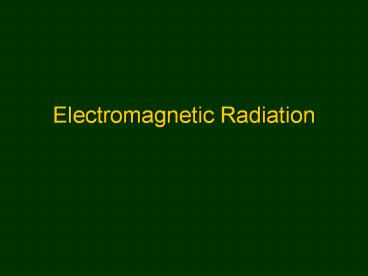Electromagnetic Radiation PowerPoint PPT Presentation
Title: Electromagnetic Radiation
1
Electromagnetic Radiation
2
Electromagnetic Spectrum
3
Light
- 1600s sunlight considered purest form of
light - 1665 Isaac Newton
- passed beam of sunlight through a prism
- beam spread out
- band of colors (Roy G. Biv)
- rejoined the colors with 2nd prism got white
light again
4
note red light bends the least, violet the most
5
(No Transcript)
6
(No Transcript)
7
Newton
- Thought light made up of tiny particles with no
mass - explains why shadows have sharp edges
- couldnt explain how different colored particles
were different or why were refracted differently
by prism - couldnt explain why 2 beams of light didnt
affect each other when crossed - particles of light should collide off each other
8
Christian Huygens
- 1678 suggested light composed of waves
- explained why 2 beams of light could cross each
other without being disturbed - explained refraction in prism
- - different colors have different
wavelengths - people were used to waves in water
- water waves move around an obstruction
- waves couldnt explain shadows with sharp edges
9
Wave Vocabulary
- Transverse and Longitudinal waves
- Wavelength
- Frequency
- Amplitude
- Velocity
10
Transverse Wave
Direction of displacement is at right angle to
direction of travel
11
(No Transcript)
12
Transverse vs Longitudinal Waves
Transverse (ocean)
Longitudinal (compression/sound)
13
Wavelength vs. Frequency
- WAVELENGTH
- distance light travels to complete 1 cycle
- FREQUENCY
- number of cycles completed in 1 second
14
(No Transcript)
15
Wave Velocity
- speed of wave in direction is traveling
- velocity wavelength x frequency
- velocity ??
16
Light Particles vs. Waves
- Huygens had better argument, but Newton was more
famous - people went with Newton's theory Light was
particles! - speed of light
- 1st determined about 1676 by Danish astronomer
- speed of light 3.0 X 108 m/sec
17
Calculating Wavelengths of Light
- visible light waves have lengths 1/20,000 cm
- red a little longer, violet a little shorter
- short wavelength explains why light cast sharp
shadows despite being waves - waves can only bend around obstacles that are
about same length - cannot bend around anything substantially longer
than itself
18
The Ether
- water waves move in water
- sound waves move in air
- light waves move through vacuum
- gravity, electricity, magnetism also felt
across vacuum - people couldn't accept this
- postulated subtle form of matter called ether
- not easily detectable
- Ether idea held until 1900
19
Maxwell
- 1864-1873 worked out mathematical equations
describing electricity magnetism - electric magnetic fields cannot exist
independently - electromagnetic radiation in Maxwells equation
moved at same speed as light! - could not be coincidence!
20
Light that cant be seen?
- light was electromagnetic radiation!
- Maxwells equations unified electricity,
magnetism, light - but visible light only accounts for a fraction of
Maxwells equations - ? other frequencies and wavelengths
21
(No Transcript)
22
Heat Light Separate or same?
- 1800 Herschel studied spectrum with thermometer
- - found highest temperature at red end
coolest at - violet end
- placed thermometer beyond red temp was higher
there than anywhere in visible spectrum - discovered Infared rays, which we cannot see
23
Infrared Radiation
- By 1850
- infrared rays were demonstrated to have all the
properties of light - except could not be seen by human eye
24
Silver Nitrate as detector
- 1614
- known that silver nitrate (AgNO3 - white cmpd)
darkens on exposure to sunlight - 1770
- Scheele soaked strips white paper in AgNO3
solutions and placed them in different parts of
spectrum - darkened least quickly in red and fastest in
violet - ? the first photographs
25
Discovery of ultraviolet!
- After Herschel discovered infrared using
thermometers - 1801 Ritter repeated Scheeles experiment with
paper soaked in AgNO3 put strips beyond violet - strips darkened even quicker than in violet light
- discovered ultraviolet light!
26
Radio Waves
- 1888
- Hertz used oscillating electric current to emit
electromagnetic radiation - had detector that could move around to map the
electromagnetic wave determine its length - found radio waves far beyond infrared radiation
- have wavelengths from cm to km
27
X-Rays
- 1895
- Roentgen discovered that his cathode ray tube was
emitting radiation X-rays
http//www.chem.uiuc.edu/clcwebsite/video/Cath.wmv
28
(No Transcript)
29
Electromagnetic Spectrum
30
Comparing Light
- LONG wavelength
- red end
- slow frequency
- low energy
- SHORT wavelength
- violet end
- rapid frequency
- high energy
All electromagnetic radiation has same velocity
3.00 x 108 m/sec
3.00 x 108 m/sec ??
31
Heat Flow
- objects hotter than surroundings lose heat as
electromagnetic radiation - higher the temp, the more intense the radiation
- hot objects glow!
- glow different colors at different temperatures!
32
Pre-Planck
- classical physics
- assume every wavelength has equal chance of being
radiated - classical wave model
- could not explain why different colors were
emitted at different temperatures
33
Planck
- shorter the wavelength, the less chance it has to
be emitted! - matter can gain or release energy only in very
small increments called quanta
34
Explanation
- Pre-Planck
- energy considered to be continuous
- could be broken into smaller smaller bits
indefinitely - Planck
- energy consists of tiny particles that cant be
divided into anything smaller

